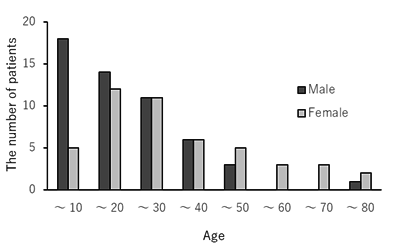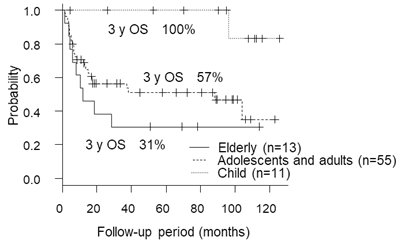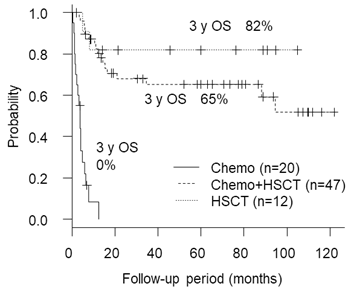News Releases & Research Results Nationwide Survey of Chronic Active EB Virus Infection Based on the New WHO Classification and the New Diagnostic Criteria - Unravelling the Differences between Childhood and Elderly Onset Cases and their Treatments -
News Releases & Research Results
Key Findings
The study is the first and the largest-scale nationwide survey after the revision of the disease definition in the WHO classification of hematopoietic tumors in 2017.
- There were clear differences in clinical features and prognosis between childhood-onset and elderly-onset CAEBV cases.
- It became evident that current chemotherapy is insufficient to treat CAEBV.
The results point out the need for further clarification of CAEBV pathophysiology and the development of new therapeutic methods.
Study Outline
Professor Ayako Arai’s group et al. (part of the Division of Hematology and Oncology, Department of Internal Medicine, St. Marianna University School of Medicine and Department of Hematological Therapeutics, Graduate School of Medical and Dental Sciences, Tokyo Medical and Dental University (TMDU)) conducted a nationwide survey of chronic active Epstein-Barr virus infection (CAEBV). This survey was the first and the largest in its scale since WHO newly defined the disease in its revised Classification of Tumours of Haematopoietic and Lymphoid Tissues in 2017 and after the disease diagnostic criteria was announced in Japan.
This study was funded under the project name “Investigator-initiated clinical research of a JAK1/2 inhibitor ruxolitinib for chronic active Epstein-Barr virus infection”, one of the Rare/Intractable Disease Projects of Japan, sponsored by Japan Agency for Medical Research and Development (AMED). The results of the study were published online in the US scientific journal Blood Advances at 12:00 PM US EST, June 29, 2020.
Background
Chronic active EB virus infection (CAEBV) is a progressive rare disease of persistent and severe inflammation accompanied by EB virus (EBV) infection of T- or NK-cells resulting in neoplastic transformation*1. The disease has been reported mainly in Japan and other East Asian countries but with few reports from Europe or North America. Because of its rareness the clinical features were not clear. In addition, although the disease is a kind of neoplasm, tumors rarely appears, a characteristic that has made pathological diagnosis difficult. Despite the adversities, recently there has been a few turning points. In 2017, after ten years WHO revised the Classification of Tumours of Haematopoietic and Lymphoid Tissues. In the new classification, CAEBV was specified as EBV-positive T- or NK-cell cell neoplasms. Since this revision, the disease started to become known among hematologists, pathologists, and researchers around the world.
In the 2017 WHO classification, CAEBV is defined in two subtypes: systemic CAEBV (sCAEBV), which involves systemic inflammation, and cutaneous CAEBV where symptoms are limited to the skin. A research group of the Ministry of Health, Labour and Welfare of Japan developed diagnosis criteria based on the 2017 WHO classification and taking into consideration the difficulty of pathological diagnosis. Before this criterion became standard, CAEBV was often diagnosed without the confirmation of T- or NK-cell EBV infection. In this research, a nationwide study was conducted to unveil the real picture of the clinical features and treatments of sCAEBV, based on the definition of the 2017 WHO classification.
Results
The study group distributed questionnaires to 1089 institutions of hematology and pediatrics in Japan and collected patient data of 100 cases. The age of patients ranged from 1 to 78 years old, with the median age of 21. More than half of the cases were of adults. The cases were divided into three groups based on the age of onset: children aged below 9, adolescents/adults aged between 10 and 45, and elderly aged over 45. Interestingly, 78% of childhood-onset were of male, while 85% of elderly-onset were of female (Figure 1). There was no apparent difference in gender in adolescents/adult-onset cases.


The prognosis of childhood-onset cases was relatively better compared to other groups (Figure 2).
15% of the cases were diagnosed using pathological examination*2, whereas the rest of the 85% were diagnosed examining blood to confirm the infection of EBV in T- or NK-cells.
In regard to treatment methods, the cases treated by hematopoietic stem cell transplantation (HSCT)*3 resulted in long-term survival: the 3-year-survival-rate of HSCT only was 85% and that of chemotherapy followed by HSCT was 65% (Figure 3). On the other hand, the prognosis of the cases treated by chemotherapy only was severe with a 3-year-survival-rate of 0% (Figure 3). There was no case of drug therapy, such as steroid, immunosuppressive drug, and anticancer chemotherapy, that eliminated EBV infected T- or NK-cells.

The Significance of the Study
The study is based on the revised 2017 WHO Classification of Tumours of Haematopoietic and Lymphoid Tissues, and this article is the latest report on the largest-scale nationwide survey of this kind. The remarkable findings are as follows:
- There were clear differences in clinical features and pathophysiology between childhood-onset and elderly-onset cases.
- No case treated by only chemotherapy resulted in complete cure, but the cases of HSCT resulted in improved survival rate.
It also became clear that blood examination is widely used for diagnosis, and yet pathological examination is not. CAEBV is drawing more attention not only inside but also outside Japan. The results of the study contribute to elucidate the pathogenic mechanism of the disease. At the same time, they thrust before us the need to establish a standardized method of diagnosis and an effective drug.
Descriptions of Terms
- *1 T, and NK cells:
- Lymphocytes, a kind of white blood cell, are classified into B, T, and NK cells. When pathogens, such as viruses or bacteria, infect human, lymphocytes activate, proliferate, and cause an immunological reaction of inflammation to suppress and expel them.
- *2 Pathological examination:
- An examination that uses a sample collected from a patient organ, tissue, or cell, to observe by a microscope or another equipment to diagnose. Cancer is generally diagnosed by pathological examination.
- *3 Allogeneic hematopoietic stem cell transplantation:
- A therapeutic treatment which involves a transfusion, which is equivalent to transplantation, of hematopoietic stem cell from a healthy person to replace a patient’s hematopoietic and immune cells. This treatment is usually done after a combination of treatments consisting of chemotherapy, immune-suppressive reagents and/or a whole‐body irradiation.
About the Journal
- Name of the Magazine:
- Blood Advances
- Title:
- Nationwide survey of systemic chronic active EBV infection in Japan in accordance with the new WHO classification
- DOI:
- 10.1182/bloodadvances.2020001451.
- Authors:
- Ichiro Yonese, Chizuko Sakashita, Ken-Ichi Imadome, Tohru Kobayashi, Masahide Yamamoto, Akihisa Sawada, Yoshinori Ito, Noriko Fukuhara, Asao Hirose, Yusuke Takeda, Masanori Makita, Tomoyuki Endo, Shun-ichi Kimura, Masataka Ishimura, Osamu Miura, Shouichi Ohga, Hiroshi Kimura, Shigeyoshi Fujiwara, Ayako Arai
- Link to the Article:
- https://ashpublications.org/bloodadvances/article/4/13/2918/461171/Nationwide-survey-of-systemic-chronic-active-EBV
06/30/20
Last updated 06/30/20

